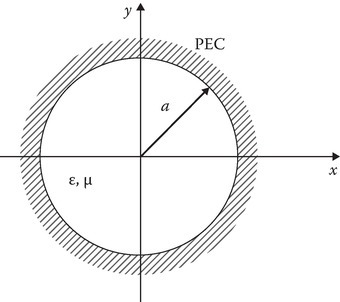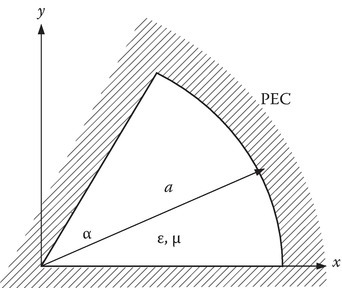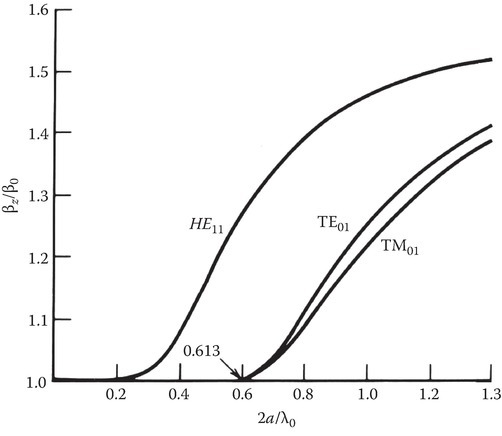]>
3
Two-Dimensional Problems and Waveguides
In the previous chapter, we examined one-dimensional solutions. We found the solutions to be plane or cylindrical TEM (transverse electric and magnetic) waves. The TEM waves are the simplest kind of electromagnetic waves.
The next level of simple waves is either transverse magnetic (TM) or transverse electric (TE). Such waves arise when the wave is confined (bounded) in the transverse plane with, say, conducting boundaries, and is traveling in a direction normal to the transverse plane.
3.1Two-Dimensional Solutions in Cartesian Coordinates
Let us investigate the solution of Maxwell’s equations under the following constraints: (1) the wave is traveling in the z-direction, (2) it has an electric field component in the z-direction, (3) there are no sources in the region of interest, and (4) the medium in the region of interest is lossless.
The ˜Ez
where
Let
The wave is a positive-going traveling wave when γ is imaginary, that is, γ = jβ, where β is real and positive. It is an attenuating wave when γ is purely real, that is, γ = α, where α is real and positive. Since the medium is assumed lossless, the attenuation in this case is due to the fact that the wave is evanescent. We will confirm this after we complete the solution.
Substituting Equation 3.3 into Equation 3.1, we obtain
where
Separation of variable method is a standard technique of solving this partial differential equation (PDE). The technique converts the PDE into ordinary differential equations (ODEs) with a constraint on the separation constants. The meaning becomes clear as we proceed. Let F be expressed as a product of two functions
where f1 is entirely a function of x and f2 is entirely a function of y. Substituting Equation 3.6 into Equation 3.4, we obtain
Differentiating partially with respect to x, we obtain
Let this constant be denoted by −k2x
Following the same argument, the second term in Equation 3.7 can be equated to −k2y,
From Equation 3.7, we can see that the constants k2x
The PDE (Equation 3.4) is converted into the two ODEs given by Equations 3.9 and 3.10 subject to the constraint given by Equation 3.12. Each ODE has two independent solutions. If the constants k2x
where K2x
The solution to a given problem may be constructed by choosing a linear combination of the admissible functions. The choice is influenced by the boundary conditions. An illustration is given in the following section.
3.2TMmn Modes in a Rectangular Waveguide
Figure 3.1 shows the cross section of a rectangular waveguide with conducting boundaries (PEC) at x = 0 or a and y = 0 or b. TM modes have ˜Ez≠0 and ˜Hz=0. The ˜Ez component satisfies Equation 3.1 inside the guide and is, however, zero on the PEC boundaries. This boundary condition translates into the “Dirichlet boundary condition” F(x, y) = 0 on the boundaries given by x = 0 or a, or when y = 0 or b. The requirement of multiple zeros on the axes, including a zero at x = 0, forces us to choose the sin kx x function for the x-variation. Moreover,

FIGURE 3.1
Cross section of a rectangular waveguide. TM modes. Dirichlet problem.
A similar argument leads to the choice of sine function for the y-variation and also
Now, we are able to write the expression for ˜Ez of the mnth TM mode:
where Emn is the mode constant of the TMmn mode. From Equations 3.5, 3.12, 3.18, and 3.19, we obtain
Equation 3.23 has to be satisfied for the wave to be a propagating wave instead of an evanescent wave. Recalling k2 = (2πf)2 με and defining
we can obtain
where
Thus emerges the concept of a mode cutoff frequency fc of a waveguide. When the signal frequency f is greater than the mode cutoff frequency fc, then the mode will propagate. When f < fc, the mode will be evanescent. Since the lowest values of m and n are 1 the lowest cutoff frequency of TM modes in a rectangular waveguide is
Once ˜Ez is determined, we can obtain all the other field components of the TM wave in terms of ˜Ez by applying Maxwell’s equations:
We have chosen ˜Ez appropriately to satisfy the boundary condition Etan = 0 on the conducting walls of the guide. However, for a TM wave, there are other tangential components that must also reduce to zero on the walls. For instance (Figure 3.1), ˜Ex=0 on the walls y = 0 or b. We note, from Equation 3.29, that this boundary condition is satisfied automatically. We also note, from Equation 3.30, that the boundary condition Ey = 0 on x = 0 or a is automatically satisfied. Thus, for the TM wave guiding problem, ˜Ez is a potential. The solution is obtained by finding ˜Ez that satisfies the Maxwell’s equation and the boundary condition of ˜Ez=0 on the conductor (Dirichlet boundary condition). The other field components are obtained from ˜Ez and the boundary conditions on the other field components are automatically satisfied.
Just as we have defined the wave impedance for the TEM wave, we can also define the wave impedance for a TM wave:
When the signal frequency is less than the cutoff frequency, Zw is purely imaginary, showing that the electric fields and the associated magnetic fields in the transverse plane are in time quadrature, the Poynting vector component in the z-direction is imaginary, and the power flow is purely reactive. The wave is evanescent.
The wavelength λ of the signal in the medium without the boundaries is given by
We can define a guide wavelength λg as
Above the cutoff, the wavelength λg is greater than the unbounded wavelength λ. It is sometimes more convenient to define a cutoff wavelength λc for a waveguide:
The waveguide mode propagates if λ < λc.
3.3TEmn Modes in a Rectangular Waveguide
TE modes have ˜Ez=0, but ˜Hz≠0. The ˜Hz component satisfies
Let
The function G satisfies
where k2c is again given by Equation 3.5.
The boundary condition on ˜Hz at the PEC walls, from Equation 2.26, is given by
where ˆn is a normal unit vector as shown in Figure 3.2. This boundary condition translates into the boundary condition on G given by Equation 3.40:

FIGURE 3.2
Cross section of a rectangular waveguide. TE modes. Neuman problem.
Like in the TM case, it can be shown that all other boundary conditions at PEC are automatically satisfied when Equation 3.41 and Equation 3.42 are satisfied:
where Hmn is the mode constant of the TEmn mode. The lowest allowed value for m or n is zero. The potential for TE modes is ˜Hz and the type of boundary value problem where the normal derivative of the potential is zero on the boundary is called the Neuman boundary value problem. The cutoff frequency fc for the TE modes is given by Equation 3.27. If a > b, then we obtain the lowest cutoff TE modes by choosing m = 1 and n = 0. The choice of m = n = 0 leads to a trivial solution that all the fields are zero in the waveguide.
3.4Dominant Mode in a Rectangular Waveguide: TE10 Mode
The lowest cutoff frequency of all modes of a rectangular cavity is given by Equation 3.49 and such a mode is referred to as the dominant mode. Figure 3.3 shows a sketch of the normalized cutoff frequencies of a rectangular waveguide with b/a = 1/2. Normally, a guide is designed so that its cutoff frequency of the dominant mode is about 30% below the operating frequency. Note that from Figure 3.3, the operating frequency is below the next order modes TE01 and TE20 and therefore, only the dominant mode can propagate. In practice, higher-order modes may be excited at the point of excitation of the guide, but they die away in a short distance from the source since the waves of these higher-order modes are evanescent. In view of the importance of TE10 mode, let us study this mode, in more detail. The fields of this mode are given by

FIGURE 3.3
Normalized cutoff frequencies of a rectangular waveguide with b/a = 1/2.
All other components are zero. The wave impedance in this case is given by
where
For this case, the cutoff frequency for the TE10 mode is given by
For f > fc, γ = jβ, where β is real, the mode propagates, and the wave impedance given by Equation 3.47 is real. For f < fc, γ = α, where α is real, the mode does not propagate, and the wave impedance is imaginary. The electric and the magnetic fields are in time quadrature, and there is no real power flow down the guide. The mode is evanescent and the fields decay signifying localization of stored energy.
3.5Power Flow in a Waveguide: TE10 Mode
It is easy enough to study the power flow of the TE10 mode. From Equation 3.46 and 3.47, we obtain
where ψ is as given by Equation 3.48. The power flow P10 is given by
3.6Attenuation of TE10 Mode due to Imperfect Conductors and Dielectric Medium
We have seen that the wave attenuates when the signal frequency is less than the cutoff frequency. The wave becomes evanescent. Even if f > fc, the wave can attenuate due to imperfect materials. The exponential factor of the fields of the wave will have the form
In the above, αc is the attenuation of the fields due to the conversion of the wave energy into heat by imperfect conductors of the guide. αd is the attenuation due to the conversion of the wave energy into heat by an imperfect dielectric. These are given by
In the above, Rs is the surface resistance of the conductor and σ/ωε the loss tangent of the dielectric. The derivation of the attenuation constant formulas is given as problems at the end of the book.
3.7Cylindrical Waveguide: TM Modes
Let
and
The separation of variable technique applied to the PDE
results in two ODEs with separation constants kc and n:
Recognizing Equation 3.59 as the Bessel equation (2.120), the solution for F may be written as a linear combination of the product of the functions given below:
Since ρ = 0 is a part of the field region, we choose Jn function for the ρ variation and from the boundary condition ˜Ez=F=0 when ρ = a (see Figure 3.4):
where χnl is the lth root of Jn and a partial list of these is given in Table 2.4.

FIGURE 3.4
Circular waveguide with PEC boundary.
The cutoff frequency is given by
Since the lowest value for χnl is 2.405 when n = 0 and l = 1, the lowest cutoff frequency for TM modes is given by
3.8Cylindrical Waveguide: TE Modes
Let
Solution for G is again given by Equation 3.61. However, in the TE case, the Neumann boundary condition
translates into the requirement
where the derivative is with respect to the argument kcρ. The cutoff wave number is thus given by
where χ′nl is the lth root of the derivative of nth-order Bessel function of the first kind. The values of χ′nl are listed in Table 2.4. The lowest value is 1.841 and occurs for n = 1 and l = 1. The lowest cutoff frequency of a circular waveguide is thus given by
3.9Sector Waveguide
Figure 3.5 shows the cross section of a sector waveguide with PEC boundaries.

FIGURE 3.5
Sector waveguide with PEC boundaries.
For TM modes, the boundary conditions are the Dirichlet boundary conditions:
From Equation 3.71, the ρ variation is given by the Bessel function of the first kind, however, the order of the Bessel function need not be an integer; the field region in this case is limited to 0 < ϕ < α. In the case of a circular waveguide, the field region is given by 0 < ϕ < 2π. The ϕ variation in such a case is a linear combination of sin nϕ and cos nϕ, where n is an integer. Such stipulation is necessary to ensure a unique value for the potential. Note that cos nϕ and cos n(ϕ + 2π) are equal only if n is an integer. For the sector waveguide, the ϕ variation is again a linear combination of cos νϕ and sin νϕ where ν need not be an integer. Bearing in mind these considerations, we write the potential
where
For TE modes
where
3.10Dielectric Cylindrical Waveguide: Optical Fiber
We have seen in Sections 3.7 and 3.8 that an electromagnetic wave is guided by a hollow cylindrical tube with a conducting boundary. The fields inside the guide were classified as TM modes (Ez = 0 on the boundary) or TE modes (∂Hz/∂n = 0 on the boundary). In either case, the fields outside the cylinder are zero. Can a cylindrical dielectric rod guide an electromagnetic wave? The answer is yes. A qualitative picture of such wave guiding as a surface wave has been alluded to before in connection with propagation of an electromagnetic wave from an optically dense to optically rare medium when the angle of incidence is greater than the critical angle. In this section, we examine the problem as a boundary value problem. Figure 3.6 shows the variation of the permittivity of a step index optical fiber in its cross section.

FIGURE 3.6
Step index optical fiber.
In contrast to the conducting guides, one notes here that the boundary condition for this case will be the continuity of the tangential electric and magnetic fields at ρ = a for all ϕ and z:
This suggests to us that, in general, we may not be able to separate the modes into TE or TM modes. A general mode in this case may be a hybrid mode having Ez and Hz components. However, we can show that the optical fiber guide can have a TM0l or TE0l mode of propagation for the special case of n = 0. Let us look at the TM case in detail. Let the ρ variation of Ez be chosen as J0(kc1ρ), for 0 < ρ < a and K0(kc2ρ) for a < ρ < ∞. The choice of modified Bessel function K0 in the latter range is to ensure that the amplitude of electromagnetic fields decay as ρ increases. This choice of the admissible function is in contrast to the choice of H(2)0 in Equation 2.121 where we needed an outgoing cylindrical wave at ρ = ∞. The formulation is given as follows:
where
It can be shown [1] that the boundary condition (Equations 3.76 and 3.79) can be satisfied if the following transcendental equation is satisfied:
The transcendental equation has several solutions giving rise to several TM modes. Next, let us consider whether the concept of cutoff frequency holds in the dielectric guiding. The cut off occurs when kc2 = 0, since for negative values of k2c2, the modified Bessel function K0 is no longer a monotonic function and the wave in medium 2 is no longer evanescent. Further consideration shows that kc2 = 0 is equivalent to J0 (kc1a) = 0 or
and
Note that at cutoff
For TE0l modes, the eigenvalue equation is given by
If n ≠ 0, then the fields do not separate into TE and TM modes. All the fields become coupled through the continuity conditions. The modes are hybrid and have both Ez and Hz nonzero. The fields for the two regions may be written as [1]
The transverse components may be obtained from Maxwell’s equations. Applying the boundary conditions (Equation 3.76, Equation 3.77, Equation 3.78 and Equation 3.79), one can obtain the eigenvalue equation [1]
where
The solutions of the transcendental equation (3.90) may be designated as χnl. For n ≠ 0, we get hybrid modes designated as HEM (hybrid electric and magnetic). The HEM modes with odd values of the second subscript are called HE modes, whereas HEM modes with even values for the second subscript are called EH modes. HE11 mode has no cutoff frequency and so is often called the dominant mode. From [2] and [3], a plot of β/k0 versus 2a/λ0 for HE11 mode, TE01 mode, and TM01 mode for the case of εr1 = 2.56, εr2 = 1, k2 = k0, λ0 = 2π/k0 is obtained (see Figure 3.7). For 2a/λ0<2.4049/π√εr−1, only the dominant HE11 mode exists.

FIGURE 3.7
Ratio of β/k0 for the first three surface-wave modes on a polystyrene rod (εr = 2.26). (Adapted from Collin, R.E., Field Theory of Guided Waves, McGraw-Hill, New York, 1960 [3].)
